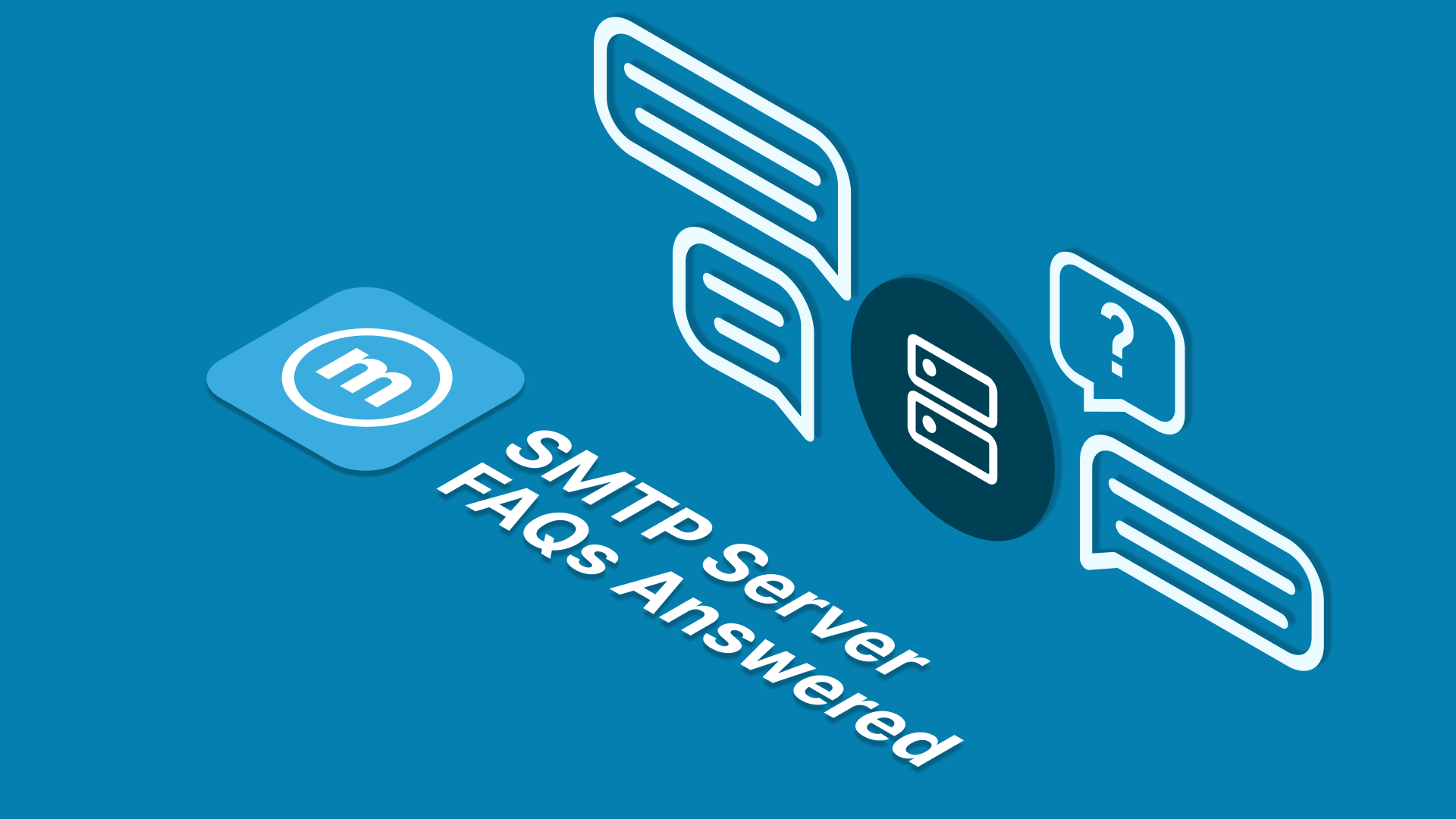SMTP server FAQs answered: An in-depth guide

If you have ever sent or received an email, you have used an SMTP server. Simple Mail Transfer Protocol (SMTP) is the standard protocol for email sending over the internet. SMTP server is a software application that acts as a middleman between your mail client and the recipient’s email server. It receives your email messages from your mail client, checks them for errors, and delivers them to the recipient’s email server.
But what exactly is an email client? And how this server work? And why do you need an SMTP for your email projects? In this article, we will answer these questions and more. We will explain what an SMTP server is, how it works, and how to set up your own SMTP server using mailtarget. We will also answer some frequently asked questions about SMTP server and provide some tips and best practices for using it.
What is an email client?
An email client is a software application that you use to compose, send, receive, and manage your emails. Some examples of email clients are Outlook, Gmail, Thunderbird, Apple Mail, etc. An email client allows you to create an email message using a graphical user interface (GUI) or a command-line interface (CLI). You can also attach files, images, or other media to your email message.
An email client needs to communicate with this server to send your email messages to the recipient. The SMTP server acts as a bridge between your email client and the recipient’s email server. The recipient’s email server then delivers your email message to the recipient’s inbox.
How does an SMTP server work?
Server works by following a series of steps to send your email messages across the internet. Here is a simplified overview of how an SMTP server works:
- You compose an email message using your email client and click on the send button.
- Your email client connects to your server using the SMTP port (usually port 25) and sends your email message along with some information such as your email address, the recipient’s email address, the subject line, etc.
- Your server checks your email message for errors and verifies that you are authorized to send emails from your domain name.
- Your server looks up the recipient’s domain name (the part after the @ symbol in the email address) in a database called DNS (Domain Name System) and finds out the IP address of the recipient’s email server.
- Your server connects to the recipient’s email server using the same SMTP port and sends your email message along with the same information as before.
- The recipient’s email server checks your email message for errors and verifies that you are authorized to send emails to their domain name.
- The recipient’s email server delivers your email message to the recipient’s inbox.
This process may involve multiple servers along the way, depending on the routing and configuration of each domain name. Each server keeps a record of the transaction in a log file.

Why do you need an SMTP server?
You may wonder why you need an SMTP server when you can just use your email client to send emails. The answer is that you need a server for two main reasons: reliability and customization.
Reliability
Using your own SMTP server can improve the reliability of your email delivery. This means that your emails are more likely to reach the recipient’s inbox without being bounced, rejected, or marked as spam. This is especially important if you are sending transactional emails, which are emails that are triggered by a user’s action on your website or app, such as password reset, order confirmation, invoice, etc.
Transactional emails are crucial for maintaining a good relationship with your users and customers. They expect to receive these emails in a timely manner and without any errors. If your transactional emails are delayed, lost, or marked as spam, you may lose trust, revenue, or reputation.
Using your own server can help you avoid these problems by giving you more control over your email delivery. You can monitor your email performance, track your delivery rates, bounce rates, open rates, click rates, etc., and troubleshoot any issues that may arise.
Customization
Using your own server can also give you more customization options for your email projects. You can create and send personalized and dynamic emails that match your brand voice and style. You can also integrate your email system with your website or app using an Email API or an Email SDK.
An Email API is an application programming interface that allows you to send emails programmatically from your code. You can use an Email API to automate your email workflows, trigger emails based on events, send emails in bulk, etc.
An Email SDK is a software development kit that provides you with a set of tools and libraries to build your email system. You can use an Email SDK to create your own email client, customize your email templates, add features such as attachments, encryption, etc.
Using an Email API or an Email SDK can help you create more engaging and interactive emails that improve your user experience and conversion rates.
How to set up your own SMTP server using mailtarget?
If you are looking for a reliable and easy way to set up your own server, you can use mailtarget. mailtarget is a service that provides email solutions for developers. You can use mailtarget to send emails using SMTP, Email API, or Email SDK. You can also use mailtarget to test your email projects in a sandbox environment before switching to the production environment.
To set up your own server using mailtarget, you need to follow these steps:
- Sign up for a free account on mailtarget.co.
- Go to the SMTP overview page and copy your SMTP credentials, such as username, password, host, port, etc.
- Configure your email client or application to use these credentials to connect to the mailtarget SMTP server.
- Send a test email to verify that everything is working correctly.
- Switch to the production environment when you are ready to go live.
You can also use the mailtarget dashboard to monitor your email performance, manage your email campaigns, create and edit your email templates, etc.
FAQs about SMTP server
Here are some frequently asked questions about SMTP server and their answers:
What is the difference between SMTP and POP/IMAP?
SMTP is the protocol that sends emails across the internet. POP (Post Office Protocol) and IMAP (Internet Message Access Protocol) are protocols that receive emails from the internet. POP and IMAP allow you to access your emails from different devices and applications. POP downloads your emails from the server to your device and deletes them from the server. IMAP syncs your emails between the server and your device and keeps them on both.
What is the difference between SMTP and HTTP?
SMTP is the protocol that sends emails across the internet. HTTP (Hypertext Transfer Protocol) is the protocol that transfers web pages across the internet. HTTP allows you to access websites from different browsers and devices. HTTP uses a request-response model, where the client requests a web page from the server and the server responds with the web page. SMTP uses a command-response model, where the client sends commands to the server and the server responds with status codes.
What are some common SMTP errors and how to fix them?
Some common SMTP errors are:
- 550: This means that the recipient’s email address is invalid or does not exist. To fix this error, you need to check the spelling of the email address and make sure it is correct.
- 554: This means that your email message was rejected by the recipient’s email server due to spam or virus detection. To fix this error, you need to check the content of your email message and make sure it does not contain any spammy or malicious elements.
- 421: This means that the SMTP server is temporarily unavailable or busy. To fix this error, you need to wait for some time and try again later.
- 503: This means that the SMTP server requires authentication before sending emails. To fix this error, you need to provide your username and password when connecting to the SMTP server.
Here are some common SMTP errors that are specific to mailtarget and how to fix them:
In this article, we have learned what an SMTP server is, how it works, and why you need it for your email projects. We have also learned how to set up your own SMTP server using mailtarget and how to troubleshoot some common SMTP errors.
We hope that this article has helped you understand more about SMTP server and its benefits. If you have any questions or feedback, please feel free to contact us at [email protected].
If you want to try out mailtarget for free, sign up now and start sending messages using SMTP, Email API, or Email SDK. You can also test your email projects in a sandbox environment before switching to the production environment. Thank you for reading and happy emailing!
(A.F)

